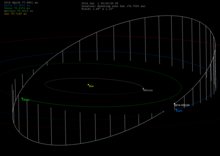2014 HQ124
Synodic rotation period | >16 h[6][7] | |
| 0.291±0.216[4][5] | ||
| S (assumed)[6] | ||
| 18.9[1][3] | ||
2014 HQ124 is a sub-kilometer
contact binary.[12]
Orbit
2014 HQ124 orbits the Sun at a distance of 0.6–1.1
semi-major axis of 0.85 AU). Its orbit has an eccentricity of 0.26 and an inclination of 26° with respect to the ecliptic.[3]
2014 close approach

On 6 June 2014, the asteroid brightened to about
astronomical twilight during the closest approach to Earth. The Goldstone Deep Space Network observed the asteroid later on 8 June 2014,[14] when the asteroid was between 3.6 and 3.8 lunar distances.[12]
Physical characteristics
According to the survey carried out by the
Radar observations at Goldstone suggest that the object is elongated and irregular in shape, with its long axis measuring at least 370 meters (1,200 feet).
Lance Benner suspects it the be a contact binary, composed of two merged objects forming a single asteroid with a lobed shape.[12]
spectral type is unknown, Warner assumes it to be an S-type asteroid, based on its high albedo, which is typical for stony asteroids.[6]
Related objects
On average, an object about the size of 2014 HQ124 will pass this close to Earth every few years.[15] Similar events, where other 100+ meter diameter asteroids have or will soon pass less than 4 LD from Earth, include:
- 4179 Toutatis (~3000 meters in diameter) passed 4.0 LD from Earth on 29 September 2004
- 2004 XP14(~500 meters in diameter) passed 1.1 LD from Earth on 3 July 2006
- (308635) 2005 YU55 (~360 meters in diameter) passed 0.8 LD from Earth on 8 November 2011
- 2014 EG45 (~140 meters in diameter) passed 3.2 LD from Earth on 4 March 2014[16]
- (357439) 2004 BL86 (~600 meters in diameter) passed 3.1 LD from Earth on 26 January 2015[17]
See also
References
- ^ a b c "2014 HQ124". Minor Planet Center. Retrieved 8 March 2020.
- ^ IAU Minor Planet Center. 28 April 2014. Retrieved 3 June 2014. (K14HC4Q)
- ^ a b c d "JPL Small-Body Database Browser: (2014 HQ124)" (2018-05-27 last obs.). Jet Propulsion Laboratory. Retrieved 8 March 2020.
- ^ Bibcode:2016PDSS..247.....M.
- ^ a b c "Asteroid 2014 HQ124". Small Bodies Data Ferret. Retrieved 8 March 2020.
- ^ a b c d "LCDB Data for (2014+HQ124)". Asteroid Lightcurve Database (LCDB). Retrieved 8 March 2020.
- ^ S2CID 54090944.
- ^ a b "JPL Close-Approach Data: (2014 HQ124)" (last observation: 2014-06-10; arc: 48 days). Retrieved 10 June 2014.
- ^ Mike Wall (6 June 2014). ""Beast" Asteroid to Fly by Earth on Sunday". Scientific American. Retrieved 6 June 2014.
- ^ @AreciboRadar (8 June 2014). "For the record, we do not use nicknames to refer to asteroids. Anthropomorphizing nature is confusing and misleading" (Tweet) – via Twitter.
- ^ "This was the closest Earth encounter by the object until at least 2307". Twitter: Michael Busch. 10 June 2014. Retrieved 10 June 2014.
- ^ a b c Dyches, Preston (12 June 2014). "Giant Telescopes Pair Up to Image Near-Earth Asteroid". JPL news. Jet Propulsion Laboratory. Retrieved 12 June 2014.
- ^ a b "2014HQ124 Ephemerides for 4 June 2014 through 10 June 2014". NEODyS (Near Earth Objects – Dynamic Site). Retrieved 3 June 2014.
- ^ Lance A. M. Benner (30 May 2014). "Goldstone Radar Observations Planning: 2014 HQ124". NASA/JPL Asteroid Radar Research. Retrieved 3 June 2014.
- ^ "Asteroid Discovered by NASA to Pass Earth Safely". Jet Propulsion Laboratory. 6 June 2014. Retrieved 7 June 2014.
- ^ "JPL Close-Approach Data: (2014 EG45)" (last observation: 2014-04-04; arc: 24 days). Retrieved 3 June 2014.
- ^ "JPL Close-Approach Data: 357439 (2004 BL86)" (last observation: 2013-03-12; arc: 9.1 years). Retrieved 3 June 2014.
External links
- Near-Earth Asteroid 2014 HQ124 Archived 14 July 2014 at the Wayback Machine (Slooh broadcast 5 June 2014)
- High Resolution Radar at Arecibo Observatory Reveals Asteroid As a Beauty, Not a Beast (USRA June 12, 2014)
- 2014 HQ124 at NeoDyS-2, Near Earth Objects—Dynamic Site
- 2014 HQ124 at ESA–space situational awareness
- 2014 HQ124 at the JPL Small-Body Database





